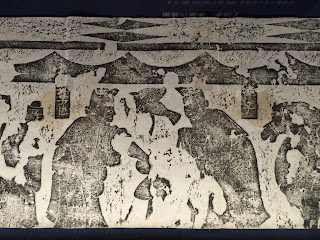展覧会ノート2016 Exhibitions Notes 2016
2017年1月3日火曜日
ラスコー展(国立科学博物館) Lascaux, The cave paintings of the ice age (National Museum of Nature and Science)
ラスコー壁画が描かれたのは、およそ2万年前。描いたのは、我々と同じホモ・サピエンスだった、クロマニョン人。
アフリカにホモ・サピエンスが登場したのは、20万年前。彼らがアフリカからヨーロッパの地に渡ってきたのは、4万年ほど前だったと考えられている。
同じ時代に、ヨーロッパの地には、すでにネアンデルタール人が暮らしていた。
残念ながら、ラスコー壁画そのものではなく、精巧な複製が、実際の洞窟を再現した会場の中に展示されていた。
なぜ人々は、ラスコー壁画を描いたのか?
専門家の見解は、個人の興味ではなく、集団としての社会的な営みではないか、というものだった。
日本にホモ・サピエンスが移動してきたのは、3万8000年前。会場には、その頃の石器、縄文時代の土器なども合わせて展示されていた。
歴史のロマンが濃厚に感じられる展覧会だった。
It was about 20,000 years ago when Lascaux murals were drawn. What I drew was the same Homo sapiens as ours, the Cromagnes.
Homo sapiens appeared in Africa 200 thousand years ago. It is believed that they came over from Africa to European land about 40,000 years ago.
In the same era, Neanderthals were already living in the land of Europe.
Unfortunately, rather than the Lascau murals themselves, elaborate reproductions were exhibited in the venue where the actual cave was reproduced.
Why did people draw Lascaux mural?
Experts' opinion was not individual interest, it was social activity as a group.
Homo sapiens moved to Japan about 38,000 years ago. In the venue, stone tools of that time, pottery of the Jomon period was also exhibited together.
It was an exhibition where the romance of history was felt rich.
(Translated by Google Translate)
2017年1月1日日曜日
岩佐又兵衛展(福井県立美術館) Iwasa Matabe (Fukui Fine Art Museum)
安土・桃山時代から江戸時代の初期にかけて活躍した、岩佐又兵衛の展覧会。
岩佐又兵衛の生涯については、まだ謎が多いが、福井に移住して400年を記念して、所縁の福井県立美術館で開催された。
色鮮やかな世界の中で、血なまぐさい凄惨なシーンが描かれる、山中常盤物語絵巻。
多くの様々な階級の人々が、2つの屏風の中で生き生きと躍動している、豊国祭礼図屏風。
他にも、岩佐又兵衛の数々の代表作が展示されていて、その独特な世界観を十二分に満喫できた。
また、東京ではなく、所縁の福井の地でこの展覧会が開催されたことに、大きな意義があるように思われた。
An exhibition by Iwasa Katabe who was active from the Azuchi · Momoyama period to the beginning of the Edo period.
Regarding Iwasa Naohi's lifetime, there are still many mysteries, but in commemoration of 400 years after moving to Fukui, it was held at the Fukui Prefectural Museum of Art, which is located in the neighborhood.
In the colorful world, a bloody miserable scene is drawn, Yamanaka Tokiwa story picture scroll.
The festival of Toyokuni festival, where many people of various ranks are lively and dynamic in the two folding screens.
In addition, many representative works of Iwasa Kaibei were exhibited, and I was able to fully enjoy the unique world view.
Also, it seemed to be of great significance that this exhibition was held in the place of Fukui which is a neighbor, not in Tokyo.
(Translated by Google Translate)
鬼才―河鍋暁斎展(富山県水墨美術館) Genius, Kawanabe Kyosai (Shiboku Museum, Toyama)
江戸時代の末から明治初期にかけて活躍した、河鍋暁斎の展覧会。
河鍋暁斎の子孫が営んでいる河鍋暁斎記念美術館の作品で構成する、本格的な展覧会だった。
残念ながら、関東近辺では開催されなかったので、富山まで足を運んだ。
17メートルの横幅の新富座妖怪引幕が全て展示されていて、圧倒的な雰囲気だった。
仏教をテーマにした絵、鬼の絵、風俗画、浮世絵、狩野派風の虎や竜の絵などなど。
実に多彩な作品が並び、河鍋暁斎が様々な技法をマスターしていたことがわかった。
美術館の敷地は広く、周囲の庭も美しかった。
An exhibition of Kawazo Kaisei, who played an active part from the end of the Edo period to the beginning of the Meiji Era.
It was a full-scale exhibition made up of works by Kawabe Akishusei Memorial Museum, which descendants of Kawazo Akaiusa run.
Unfortunately, because it was not held in the vicinity of Kanto, I went to Toyama.
All 172 meters wide Shintomida youkai ceremony was exhibited, and it was overwhelming atmosphere.
Picture with Buddhist theme, Demon painting, Genre painting, Ukiyo-e, Kano-style wind tiger and dragon paintings etc.
A variegated work was lined up, and it turned out that Kawabe Akaiusi was mastering various techniques.
(Translated by Google Translate)
12 Rooms 12 Artists(東京ステーションギャラリー) 12 Rooms 12 Artists (Tokyo Station Gallery)
スイスに拠点を置く、スイスの金融グループ、UBSグループが所有する現代アートの作品から、12人のアーティストを12のスペースに分けて展示する、というユニークな企画。
12人の作品数にはばらつきがあり、1点しかないアーティストもいれば、27点も展示されているアーティストもいた。
ルシアン・フロイドは、ジーグムント・フロイドの孫ということで、これまで気になっていたアーティストだったので、作品を見ることができて良かった。
意外と正統的なスタイルだった。
エド・ルーシェイというアーティストもこれまで知らなかったが、広告のようなポップなアートは、印象的だった。
Unique project that 12 artists are displayed in twelve spaces from works of contemporary art owned by Swiss financial group UBS group based in Switzerland.
There were variations in the number of 12 people 's work, some artists had only one point, and some 27 exhibited artists.
Lucian Floyd was a grandson of Siegmund Floyd, it was an artist I was concerned with so far, so it was good to see the work.
It was an orthodox style unexpectedly.
I did not even know the artist Ed Rushay so far, but pop art like advertisement was impressive.
(Translated by Google Translate)
2016年12月31日土曜日
もっと知ろうよ!儒教(東洋文庫ミュージアム) Learn more! Confucianism (Toyo Bunko Museum)
儒教についての、様々な文献資料を展示した展覧会。
日本では、儒教とは、教えという規範的なイメージが強いが、中国では、先祖の崇拝なども含めた、宗教の側面が強い。
老子と孔子がともに描かれた壁画。ここでは、孔子が老子に教えを乞うというシーンになっている。
儒教の日本への影響も大きかった。
論語などの書物を解釈する、ということ自体が、学問することを意味した。
救世済民を訴え、世直しを求めて挙兵した大塩平八郎の書物も展示されていた。大塩も儒学者だった。
改めて、儒教とは何かを考える、良い機会となった。
An exhibition of various literature materials about Confucianism.
In Japan, Confucianism has a strong normative image of teaching, but in China there is a strong aspect of religion, including ancestral worship.
Mural painting with Lao and Confucius drawn together. Here, Confucius has become a scene to ask Laon for teaching.
The influence of Confucianism on Japan was also great.
Interpretation of books such as a thesaurus itself, meaning to learn.
A book of Heihachiro Oosa, appealing for salvation civilians and sacrificing for reworking, was also exhibited. The large salt was also Confucian.
Again, it was a good opportunity to think about what Confucianism is.
(Translated by Google Translate)
河井寬次郎と棟方志功(千葉市美術館) Kawai Kanjiro and Munakata Shiko (Chiba City Museum of Art)
柳宗悦らとともに、民藝活動を主導し、自らも製作者だった、河井寬次郎と棟方志功の生涯と作品をたどる展覧会。
河井寛次郎は、柳とともに訪れた朝鮮で、素朴な味わいの陶磁器を見て、それまでの技巧的な取り組みを放棄して、以降は実に素朴な作品を製作するようになった。
棟方志功は、はじめは洋画を学んでいたが、やがて版画に自分の可能性を見出し、柳に作品を注目され、柳や河井らとともに活動するようになった。
河井の素朴な当時もいいが、棟方志功の版画作品の方が印象に強く残った。
華厳譜、菩薩釈迦十大弟子板畫柵、萬朶譜などの、複数の版画で一つの作品を構成するものは、圧倒的な力を感じた。
Together with Mr. Yanagi and Mr. Yanagi, the exhibition traces the life and works of Kojiro Kawai and Mr. Shiko Munakata, who led the folkloric activities and were also producers themselves.
Kawai Kazujiro, who visited with Yanagi in Korea, saw a rustic flavor of pottery, abandoned his previous technological efforts, after that he began to make a really simple work.
Mr. Shiko Mujira initially studied Western painting, but eventually found out his possibility in the prints, attracted the work to Yanagi, and began to work with Yanagi and Kawai et al.
Kawai's rustic time was nice, but the printmaking by Mikata Shiko remained stronger in the impression.
Things that constitute one work with multiple prints, such as Kogen scores, Bodhisattva Buddha Ten great disciples boards, Feng Shui, Fan Seiji, etc., felt overwhelming power.
(Translated by Google Translate)
シーボルトの日本博物館(国立歴史博物館) Siebold's Japan Museum (National History Museum)
19世紀に日本を訪れて、日本人に医学を教えつつ、日本を様々な側面で研究し、多くの文物を持ち帰ったシーボルト。
彼は、生まれ故郷のドイツに日本博物館を作る構想を持っていたが、残念ながら、その夢は叶えられなかった。
そのシーボルトの夢の一部を、日本で再現したユニークな展覧会。
今回、展示されたのは、そのうちのほんの一部だけだが、とにかくジャンルの豊富さに驚かされた。文字通り、博物だ。
仏像、蒔絵の美しい箱などの工芸品、絵画などの美術品はもとより、日常的に使われる茶碗や履物もあれば、かるた、千代紙、玩具などもある。
また、シーボルトが日本を追放されるきっかけになった、樺太地方などの地図など。
わざわざ日本の絵師に、日本の風土や行事を描かせた絵巻などもある。
とにかく、シーボルトという人物の日本に対する関心の高さに驚かされた。
それこそが、博物学、という学問の真髄なのだろう。
This time, only a part of them was exhibited, but I was amazed at the abundance of genres anyway. It is literally a museum.
Besides crafts such as Buddha statues, beautiful boxes of Makie, art objects such as paintings, as well as tea bowls and footwear routinely used, there are also Karuta, Chiyogami, and toys.
Also, maps such as the Sakhalin region where Siebold was triggered to be banished from Japan.
There is also a picture scroll that bothers Japanese painters to draw Japanese climates and events.
Anyway, I was surprised by the high interest in Japan about Siebold.
That is the essence of the academic field of natural science.
(Translated by Google Translate)
登録:
投稿 (Atom)















